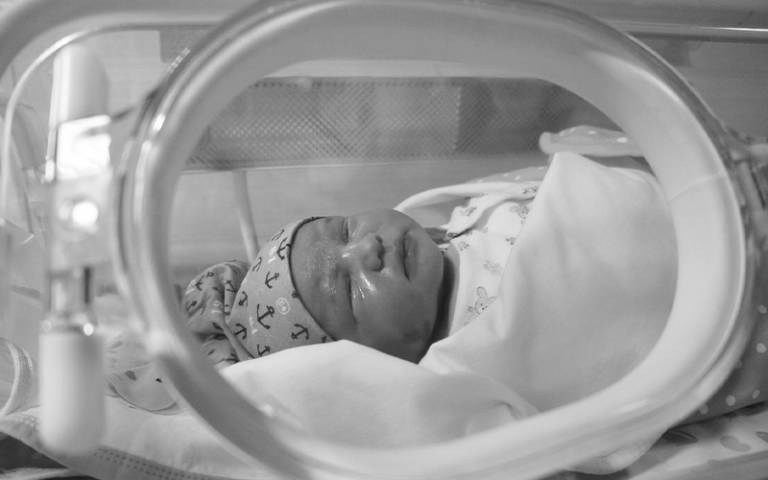The Effect of Lighting in Neonatal Intensive Care Units
28 April 2021
Environmental Design and Engineering MSc student Antonia Matthews reviews the healing potential of daylight in healthcare facilities.

One in seven infants born in the UK will spend time in a Neonatal Intensive Care Unit (NICU) [1]. Depending on an infant’s age and health upon admittance to a NICU, they will stay on average 4 to 92 days [2]. The environment in NICUs is significantly different to what an infant would experience in a womb and while in NICUs, preterm infants must contend with developing their organ systems and central nervous systems. Therefore, architects and interior designers must create NICUs that provide an environment that is optimised to promote infant health and development. If incorrectly designed, a NICU environment can cause neonatal stress, resulting in energy expenditure, hampering health and development, and possibly destabilising the fragile balance of an infant’s life [3]. The biggest sources of disruption and potential harm have been identified as light, noise, taste, touch and smell [4].
Wombs provide a low-light environment for foetuses to develop within, so direct light exposure should be avoided [5]. Infants under 30 weeks of gestational age have yet to develop an ability to regulate light entering the retina, so their incubators should be protected to avoid exposing them to light levels greater than 20 lux [6]. Cycled lighting should be utilised to promote circadian rhythms, resulting in improved sleep, weight gain and cardiorespiratory function [7]. The change between day and night lighting should be gradual to avoid unnecessarily awakening the infants [3]. Lights in NICUs should range from 10600 lux. During the day, a lighting level of 100-200 lux combined with natural light should be used, and at night the maximum level should be 50 lux. To allow staff to work effectively within the NICU, separate portable spotlights of up to 2,000 lux will enable staff to treat each infant separately without light spilling onto and harming other infants. Infants’ eyes will be covered by the staff to protect them when they are being treated [8].
Natural light in NICUs helps to reduce electricity usage and increases the usability of the space and mental wellbeing for staff and families during the day. However, natural light has to be carefully controlled as it can cause harmful glare and bright spots of light [9]. Incubators and cots should be situated at least 60cm away from windows [8].
To reduce uncertainties in NICU lighting design, such as narrowing down the recommended lighting level in NICUs, more studies with larger sample sizes and in NICUs in different hospitals needs to be undertaken. The current guidelines for NICU lighting design are outlined in Standards 22-25 in the ‘Recommended standards for newborn ICU design’ [10]. The recommended ambient lighting level range is 10-600 lux which allows too much room for potentially harmful effects.
References
- RCPCH. National Neonatal Audit Programme (NNAP) 2019 annual report on 2018 data. ; 2019 December.
- Imperial College London. Neonatal Data Analysis Unit Report. Imperial College London, Neonatal Data Analysis Unit (NDAU); 2016.
- Zores C, Pebayle T, Astruc D, Kuhn P. Observational study found that even small variations in light can wake up very preterm infants in a neonatal intensive care unit. Acta Pædiatrica. 2018 July; 107(7): 1191-1197.
- Altimier L, Phillips RM. The Neonatal Integrative Developmental Care Model: Advanced Clinical Applications of the Seven Core Measures for Neuroprotective Family-Centered Developmental Care. Newborn and Infant Nursing Reviews. 2016 September.
- Venkataraman R, Kamaluddeen M, Amin H, Lodha A. Is Less Noise, Light and Parental/Caregiver Stress in the Neonatal Intensive Care Unit Better for Neonates? Indian Pediatrics. 2018 March 14; 55(1): 17-21.
- Sanz-Segura R, Manchado-Perez E, Ferrer-Duce MP, Gonzalez de la Cuesta D, Ozcan E. Design Guidelines for Light and Noise Management in the Neonatal Intensive Care Unit. In Advances in Design Engineering.; 2019. p. 284-293.
- Marzouk SA, Hussein AA, Aziz SMA. Effectiveness of cycled lighting in neonatal intensive care unit on weight and cardiorespiratory function in preterm infants. Internation Journal of Research in Paediatric Nursing. 2019; 1(1): 1-7.
- Villaba A, Monteoliva JM, Rodrıguez R, Pattini A. A dynamic performance analysis of passive sunlight control strategies in a neonatal intensive care unit. Lighting Research & Technology. 2016 June 29; 50: 191-204.
- Rodríguez RG, Pattini AE. Neonatal intensive care unit lighting: update and recommendations. Archivos Argentinos de Pediatria. 2016; 114(4): 361-367.
- White RD, Smith JA, Shepley MM. Recommended standards for newborn ICU design, eighth edition. Journal of Perinatology. 2013; 33.
Image by Engin Akyurt from Pixabay
 Close
Close

